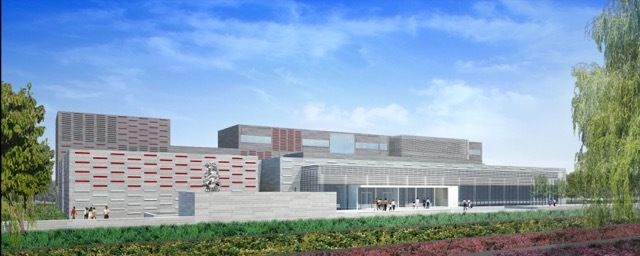
R
E
V N
E
X
T
In China, a country known for its thousands of construction sites, one unique project stands out: a teaching museum that intends to study world history through the lenses of art history and archaeological artifacts. Since November 2012, construction in Hangzhou, a city just south of Shanghai, has been in progress on the highly-anticipated teaching museum, Zhejiang University Museum of Art and Archaeology (ZUMAA). Scheduled for completion in early 2017 (with a mid-year opening), the museum’s new 25,000-square-meter world-class facility aims to be the first of its kind in China, and to create a new cultural and educational destination for the local public, students and visitors from around the world.
ZUMAA was conceived by art historian and honorary Princeton University professor Dr. Wen Fong, and the project is managed by Zhejiang University. Overseen by a council, who’s members will be representatives of the university, alumni and the public, ZUMAA will provide the university’s students with art history courses as well as public programs, such as movies and seminars on art history and archaeology. Much more than simply an addition to the University’s humanities departments, the museum is made possible by multiple United States-China partnerships, including financial support from the West Lake Society. The Boston-based nonprofit, which works to increase art historical education within the Chinese liberal arts by raising funds in the US and abroad, will aid in the expansion of ZUMAA’s collections and programs.
Award-winning New York-based firm Gluckman Tang Architects has undertaken the design of the contemporary building, which is loaded with references to traditional Chinese design. The structure is composed of two main buildings: the entryway and exhibition spaces, and the academic wing with its own ramped entrances. When viewed from the south, the superimposition of the first building upon the latter creates three parallel visual segments reminiscent of traditional Chinese landscape painting. At the entrance to the academic building, university students will be provided with amphitheater-style seating in a sunken courtyard. The façade, inspired by traditional Chinese masonry, uses large concrete units to reference local brickwork.
All told, the institution will contain a 9,100-square-meter exhibition space, conservation areas and storage space for the collections, in addition to academic departments and a library housing more than 160,000 volumes. With these state-of-the-art spaces, and under the guidance of Dr. Fong, the museum will provide many of the opportunities and facilities necessary to advance the studies of art history and archaeology in not only the Chinese liberal arts education system, but also among the general public.



